-
Car Reviews
- Car News
-
Car Comparisons
Latest comparisons
- Chasing Deals
Facelifted and more tech-savvy but no longer the bargain it once was, the Volkswagen Polo follows its Golf sibling in bringing premium to the masses
The facelifted Volkswagen Polo’s price of entry has climbed by $6230. That represents a 32 percent increase for the now $25,200 (before on-road costs) Polo Life 70TSI manual that effectively replaces last year’s Polo Trendline model … except that in reality, the Life is a better equipped, more premium vehicle than the barebones Trendline.
Hardly the only light car to cop a major price increase in recent times, the once-bargain Polo follows rivals such as the Mazda 2 G15 Pure ($21,190) and Toyota Yaris ($23,740) in becoming less accessible to first-car buyers – the Polo’s hike not only reflects market trends, but the hugely bolstered standard equipment levels of the new model.
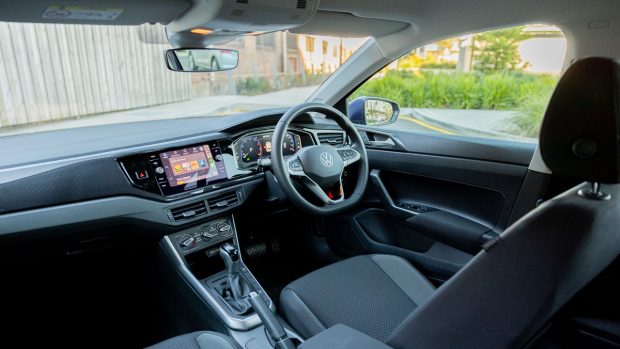
The Life is now equipped with LED headlights, front AEB with pedestrian and cyclist detection, lane-keep assist and a front centre airbag to name just a few features, and, ditching its hubcaps and steel wheels, it no longer looks like a base model outside.
An optional $1700 vision and tech pack was fitted to our vibrant violet tester, too. This brings wireless smartphone connectivity, adaptive cruise control, lane-trace assist and a 10.25-inch digital driver’s display to the base Polo – all significant upgrades over the previous model.
The truth is that the new base model Polo isn’t really a base model (and it certainly doesn’t perform like one on the road), if you’re following Volkswagen’s range structure the ‘Life’ variant is aligned as a mid-spec versions of both the Golf and Tiguan.
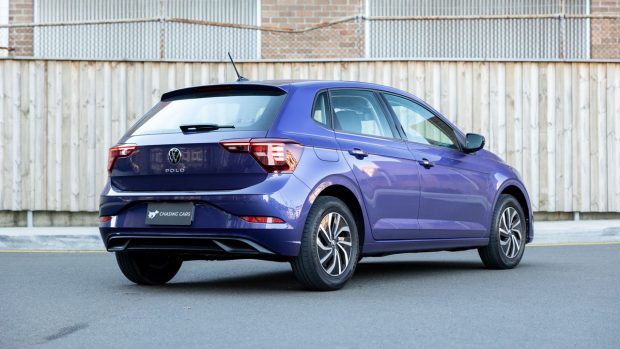
But do all the tweaks to the Polo on paper, including new front and rear fascias, different alloy wheels designs, a refreshed paint colour palette and heaping interior technology justify the Polo supermini’s increased price?
Volkswagen hasn’t mucked around with how the Polo drives – it’s still one of the best small hatchbacks to steer. There have been specification tweaks – for example a move to 185/55R15 Goodyear Efficientgrip tyres on the new 15-inch ‘Essex’ alloy wheels (no more hubcaps!), though ultimately the MQB-A0 platform, its suspension settings and powertrain performance remain almost identical.
The 999cc turbo petrol three-cylinder is the sole powertrain for regular Polos and is available in 70kW/175Nm guise paired to a five-speed manual transmission, or in a higher 85kW/200Nm ‘85TSI’ state of tune now exclusively paired to a seven-speed, dry-clutch DSG automatic transmission.
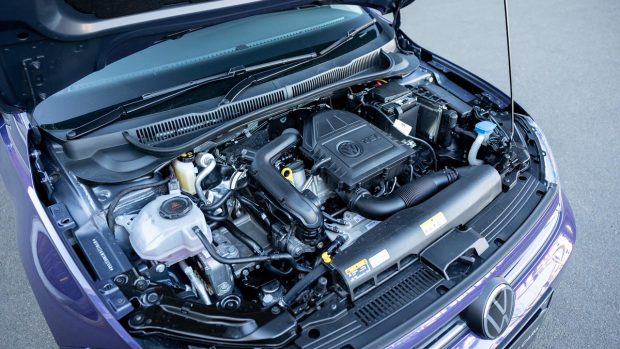
The popular Polo GTI hot hatch continues to represent a huge performance upgrade, swapping the turbo-triple for a muscular 2.0-litre turbocharged four-cylinder petrol making 147kW/320Nm. We’ve reviewed the updated Polo GTI here.
Don’t mistake the three-cylinder for an anaemic engine, though, as the Polo’s 200Nm of torque make it feel quicker than it truly is. Only the gearbox’s low-speed hesitation to select the correct gear is sometimes frustrating. This might be due to this being one of Volkswagen’s lower-torque, lighter-duty dry-clutch units – we’ve recently found the heavier-duty wet-clutch units used on higher-torque Volkswagen engines are essentially flawless.
Away from awkward low-speed manoeuvres like three-point turns, the DSG shines, with shift paddles also allowing self-shifting. These paddles sit behind a great steering wheel – it’s well-sized and has actual, physical shortcut buttons in place of the annoying touch-capacitive pads found on the GTI’s tiller, giving the driver control of the dual-clutch’s slick and satisfying changes.
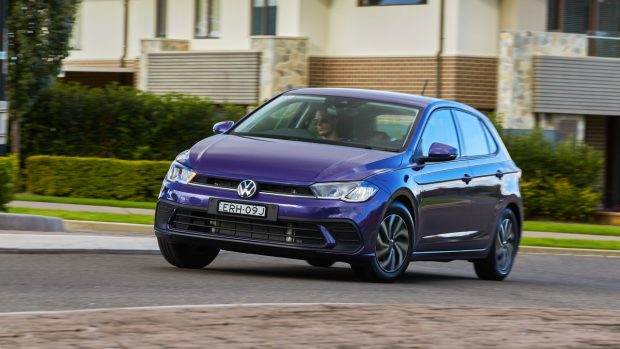
Riding on passive dampers, the standard Polo actually doesn’t ride quite as well as the more overtly sporty GTI, which gets more advanced two-stage dampers. With its 15-inch wheels the base car is plush and cosseting around town, but the Style’s ($31,250 before on-road costs) 16-inch items definitely introduce a little more harshness. This firmness is amplified by the Polo’s the torsion-beam rear suspension, a simpler solution than the bigger Golf, which scores a more compliant multi-link independent rear end.
The trade-off from a firm ride is the Polo’s taut body control. Where a Mazda 2 is fun and a little flighty, and the Kia Rio GT-Line firm but ultimately unengaging, the Polo strikes a great balance. Punting it through roundabouts is a joy thanks to a planted yet adjustable chassis.
The Polo is also surefooted on the motorway where it truly feels a size-class up in terms of composure and relaxation, there’s no buffeting from the wind or nervousness when overtaking large trucks. Noise suppression is also excellent for a car of this size with minimal road roar making its way into the Polo’s airy cabin.
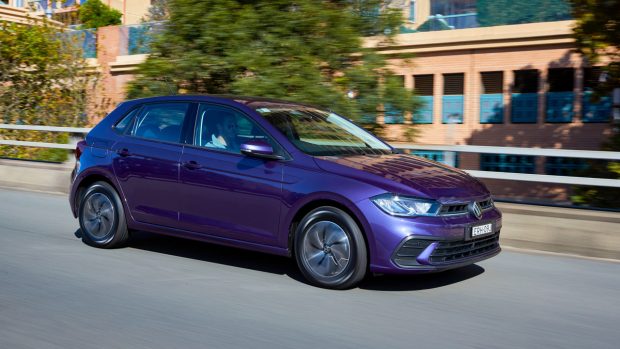
These were always traits of the Volkswagen Polo, of course, but now it’s also much safer owing to the fitment of a front centre airbag, front AEB with pedestrian and cyclist detection, lane-keep assist, front and rear parking sensors. The result is a renewed five-star ANCAP rating for 2022 (a rare feat for a mid-life facelift) and an exceptional 94 percent adult occupant protection score.
The optional pack that adds adaptive cruise and lane-trace assist is worth it as the tuning of the driver aids is rather excellent, in fact far better than many of the Polo’s rivals which only reinforces the fact that the Polo truly offers a premium small vehicle driving experience.
The Polo is peachy out on the road, and while it doesn’t match an up-spec version of the closely-related Audi A1 in terms of interior wow-factor, compared to its direct price rivals the new Polo Life is quite impressive.
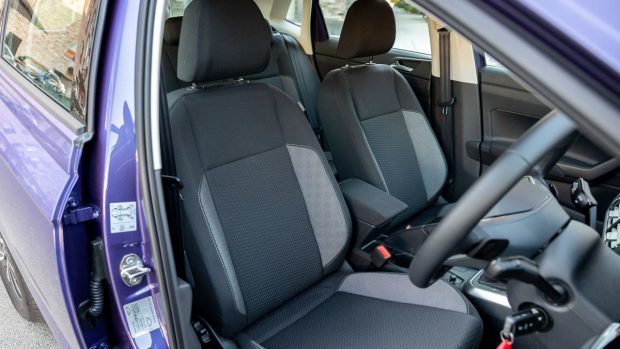
There are no lashings of leather in the Polo (even in GTI spec) but the cloth upholstery is a nice textile that avoids feeling scratchy, and the manually-adjustable seats offer plenty of customisabiltiy with infinite backrest adjustment using a rotary knob and manual lumbar adjust, resulting in a very comfortable driving position and great view out over the soft-touch dashboard.
Our car is fitted with the $1700 vision and tech package taking the 8.0-inch touchscreen and adding a more powerful processor and navigation that can be shown in the 10.25-inch digital driver’s display. It’s worth noting that the wireless smartphone mirroring present in this pack works more reliably than that tested in multiple Hyundai and Kia products. We think that it’s worth spending the money on the pack to enhance and partially future-proof the Polo experience.
A wireless charging pad is standard fitment on every Polo, as are a pair of fast-charging USB-C ports in the front, two small cup holders, a flock-lined covered storage cubby with adjustable armrest above, and door cards big enough for a 700mL bottle.
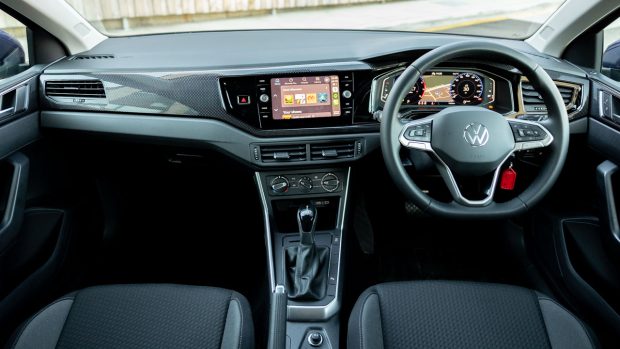
Only some scratchy plastics can be sought out, namely on the door cards and around the centre console. The Polo also doesn’t move to the Golf’s gear toggle and retains a physical stick with shortcut buttons around it for the front and rear parking sensors and engine start-stop.
We do wish, however, that the base Life was available with keyless entry and push-button start as having to fish a fob out of your pocket, hit the unlock button, flick the key out and twist it in the ignition is starting to feel decidedly old-hat.
In the second row, the Polo is as it always was – spacious for its size but not quite as generous in its smarts as a T-Cross. The light SUV relation gets a sliding bench that allows owners to prioritise luggage or occupant space.
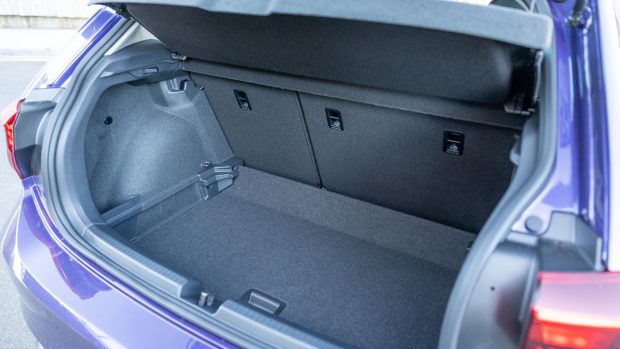
Still, four six-foot adults will be comfortable in the Polo for reasonable distances, and there’s plenty of headroom with good visibility out, Isofix ports for both outboard seats, three top-tether points and a pair of USB-C charging points.
The boot remains the same as before in the Polo with 351 litres of capacity on offer – only 30 shy of a Golf and actually more generous than a Toyota Corolla with a space-saver spare tyre to boot.
Maintenance is due every 12 months or 15,000kms for the Polo. If you choose to pay-as-you-go the little Polo can be quite expensive, so Volkswagen’s care plans are a good option.
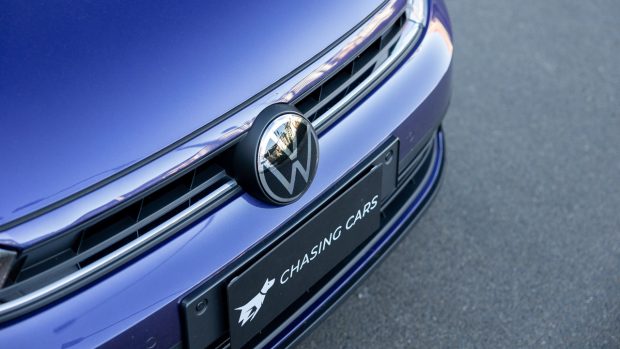
The five year/75,000kms care plan costs either $2150 for the 70TSI manual, or $2200 for the seven-speed auto. Choosing to pay-as-you-go on the 85TSI DSG will cost 30 percent more ($2903) over the same period.
That is expensive next to rivals, with the Kia Rio GT-Line costing $2128 for 75,000km, the Mazda 2 $1328 for 50,000km and a Toyota Yaris a mere $1025 for 75,000km of motoring.
The Polo’s ADR 81/02 combined fuel consumption figure of 5.4L/100km was pretty true-to-life, with our test returning 5.8L/100km in a mix of driving, and 6.1L/100km commuting in Sydney traffic.
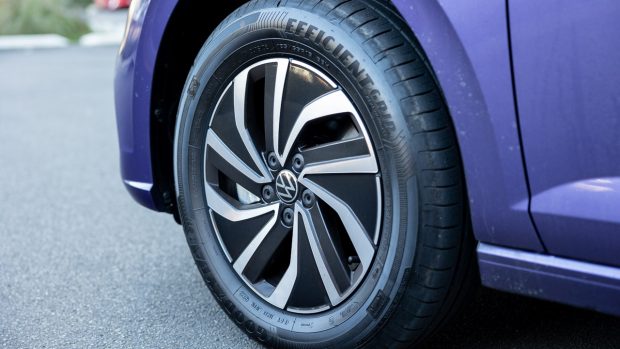
This was a good result, however those who really want to lower fuel consumption are going to be better served by a Toyota Yaris hybrid which easily gets down to 4.5L/100km, or perhaps an all-electric option such as the Mini SE.
Volkswagen’s five year/unlimited kilometre warranty matches the industry standard, however both the Kia Rio and MG 3 light cars are covered by longer seven year warranties.
So is the new, feature-packed base model Polo Life the one to buy? It’s definitely worth stretching for the $1700 Vision and Tech pack that then brings this car’s as-tested price up to $29,950 before on-road costs.
But this is one of the few light cars that transcends its size in its driving experience. The Polo is truly grown up with good suspension comfort, a refined three-cylinder engine and now heapings of safety and cabin technology to make rivals look positively stone-age.
The base model Life, though, isn’t our pick of the bunch. The Style’s more attractive alloys and fuller standard specification list make it more enticing, but really it’s the sporty GTI at the top of the range that pulls off the best bang-for-buck ratio.
None of this is to say that the Life isn’t worth a close look, though, as it’s still a fantastic light car – quite possibly best-in-class – and in vibrant violet is a charming urban runabout with plenty of refinement there if you need it to go further afield.
Variant tested LIFE
Key specs (as tested)
About Chasing cars
Chasing Cars reviews are 100% independent.
Because we are powered by Budget Direct Insurance, we don’t receive advertising or sales revenue from car manufacturers.
We’re truly independent – giving you Australia’s best car reviews.
The estimate provided does not take into account your personal circumstances but is intended to give a general indication of the cost of insurance, in order to obtain a complete quote, please visit www.budgetdirect.com.au. Estimate includes 15%^ online discount.
^Conditions Apply
Budget Direct Insurance arranged by Auto & General Services Pty Ltd ACN 003 617 909(AGS) AFSL 241 411, for and on behalf of the insurer, Auto & General Insurance Company Limited(ABN 42 111 586 353, AFSL 285 571).Because we don’t know your financial needs, we can’t advise you if this insurance will suit you. You should consider your needs and the Product Disclosure Statement before making a decision to buy insurance. Terms and conditions apply.
Indicative quote based on assumptions including postcode , 40 year old male with no offences, licence suspensions or claims in the last 5 years, a NCD Rating 1 and no younger drivers listed. White car, driven up to 10,000kms a year, unfinanced, with no modifications, factory options and/or non-standard accessories, private use only and garaged at night.
^Online Discounts Terms & Conditions
1. Discounts apply to the premium paid for a new Budget Direct Gold Comprehensive Car Insurance, Third Party Property Only or Third Party Property, Fire & Theft Insurance policy initiated online on or after 29 March 2017. Discounts do not apply to optional Roadside Assistance.
2. Discounts do not apply to any renewal offer of insurance.
3. Discounts only apply to the insurance portion of the premium. Discounts are applied before government charges, taxes, levies and fees, including instalment processing fees (as applicable). The full extent of discounts may therefore be impacted.
4. We reserve the right to change the offer without notice.